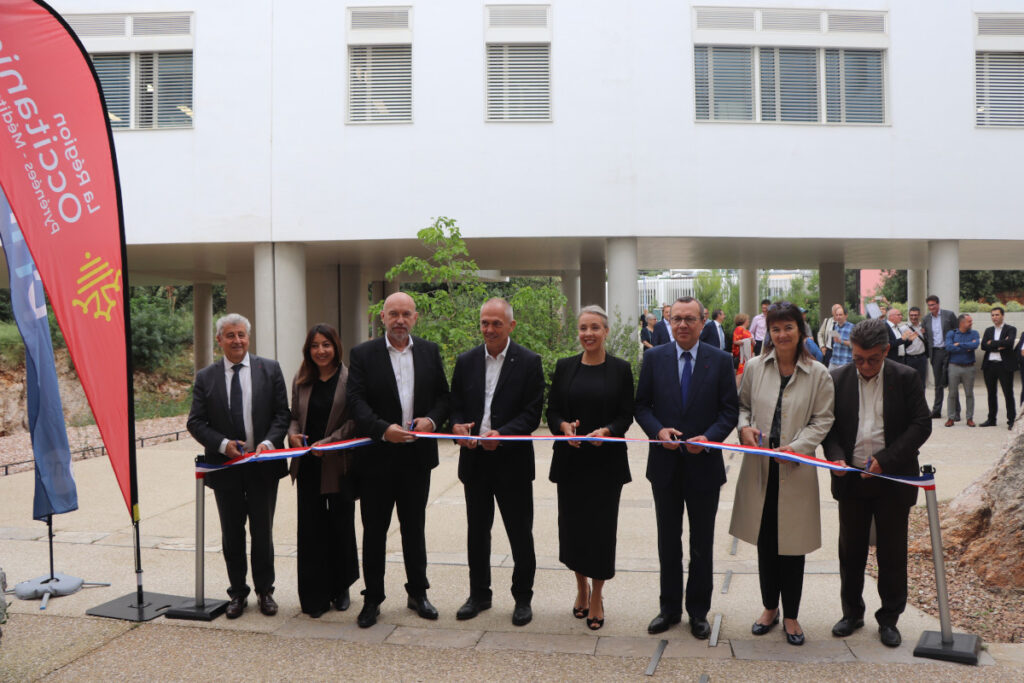The new Balard Chemistry building adds a new dimension to research
The new Chimie Balard building, now considered the largest real estate project dedicated to chemical research in France, was inaugurated on June 13, 2023, at the CNRS in Montpellier. This inauguration was an opportunity to highlight the joint CNRS/Michelin HydrogenLab laboratory, whose large-scale partnership is based primarily on ambitious fundamental research with the aim of responding to a large number of major industrial challenges in the hydrogen sector.

With its 25,500 m² of floor space capable of accommodating 800 people and its 2.5 kilometers of bench space, the new Balard chemistry building located on the CNRS campus on Route de Mende is the largest chemistry research center in France. It was inaugurated on Tuesday, June 13, by Pierre-André Durand, Prefect of the Occitanie region and Prefect of Haute-Garonne; Nadia Pellefigue, Vice President of the Occitanie Region responsible for Higher Education, Research, Europe, and International Relations, representing President Carole Delga; and Antoine Petit, President and CEO of the CNRS.
This building, financed to the tune of €62 million by the Occitanie/Pyrenees-Mediterranean Region and €1 million by the CNRS, houses the research teams of the Max Mousseron Biomolecules Institute (IBMM) and the Charles Gerin Institute. Pyrénées-Méditerranée Region and €1 million by the CNRS, houses the research teams of the Max Mousseron Biomolecules Institute (IBMM) and the Charles Gerhardt Montpellier Institute (ICGM), the joint research units of the CNRS, the University of Montpellier, andthe ENSCM.
The largest chemistry research center
With this new building, Montpellier is now home to France's largest chemistry research center, both in terms of surface area and staff numbers. The center is designed to meet the high technical requirements of the research activities carried out there, with 244 research modules designed to accommodate nearly 800 people, an analysis and characterization platform housing heavy and medium-heavy equipment dedicated to research teams and industrial partners, and an innovation and transfer center designed to host start-ups in the field of green chemistry.
The Balard building is at the center of an integrated campus of exceptional size, covering all disciplines of chemistry and its applications, particularly in the fields of energy (hydrogen and batteries), health (active ingredients, drugs, biomaterials, living molecules), the environment (air and water quality, seawater desalination), and green chemistry (biomass conversion).
Focus on hydrogen
This new building houses, among other things, the joint CNRS/Michelin HydrogenLab laboratory, which aims to bring together the expertise of the Charles Gerhardt Institute of Montpellier (ICGM), a joint research unit of the CNRS, the University of Montpellier, and the ENSCM Michelin HydrogenLab, which aims to bring together the expertise of the Charles Gerhardt Institute of Montpellier (ICGM), a joint research unit of the CNRS, the University of Montpellier, and the ENSCM, and that of Michelin's Research & Development Operations Department (DORD) in the study of hydrogen to develop virtuous and innovative materials.
This joint laboratory aims to develop new fuel cell core and electrolyzer materials using new approaches to the development and shaping of these materials in order to increase the sustainability of the hydrogen sector. The collaboration plans to develop six projects, including theses, post-doctoral research, and master's internships, which will focus on improving catalysts for water electrolysis and developing new membranes and nanofiber networks that will significantly improve durability.
Montpellier chemistry, a community working in synergy
The Balard Chemistry Cluster was created in 2007, at the instigation of the Region and the State, in order to structure the chemistry sector by giving it real visibility and strong governance, formalizing the will of the universities, schools, and supervisory bodies of the chemistry laboratories: the University of Montpellier (UM), the École Nationale Supérieure de Chimie de Montpellier (ENSCM), the French Atomic Energy and Alternative Energies Commission (CEA), and the National Center for Research (CNRS).
Located geographically close to the Triolet Campus of the University of Montpellier and on part of the CNRS campus, the two Chimie Balard Formation and Research buildings Research the beating heart of chemistry in Montpellier. This grouping of the two largest laboratories in the immediate vicinity of the European Institute of Membranes has led to the emergence of an exceptional scientific campus, one of the very first in Europe, competing with the chemistry departments of prestigious European universities such as ETH (Zurich, Switzerland), Oxford and Bristol (United Kingdom), and the German center of excellence at the Max Planck Institute for Coal Research (Mülheim).
The Balard Chemistry Cluster, which also includesthe Marcoule Institute of Separative Chemistry in the Gard region, aims to offer an ambitious project for the development of chemistry, bringing together skills and resources for sustainable development based on three areas: energy and materials; preserving resources and protecting the environment; and chemistry for human health and well-being.
Some figures about the Balard chemistry building:
- 250,000 m³ of air extracted per hour, 2.5 km of workbenches.
- The shared analysis and characterization platform (PAC), covering more than 1,600 m² and open to both research teams and companies, houses heavy and medium-heavy equipment (NMR spectrometry, diffractometers, etc.).
- The building was designed by the firm Reichen et Robert & associés, and the CNRS was responsible for project management.
- The building also received exceptional government assistance through the DSIL fund (€1 million), allocated for the relocation of all equipment and devices from 15 buildings spread across four separate sites.